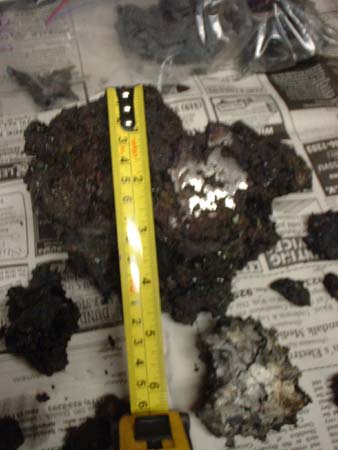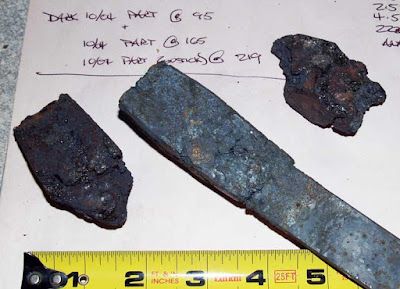My smelting partner Neil Peterson was up again yesterday for another session forging bloom pieces down to working bars. For Neil this is skills development, for me it is nudging me into the forge.
Although hardly conclusive, I thought I would pull together some (very!) rough numbers on ore / bloom / bar. The purpose of these working sessions has been primarily to bring Neil's skill at forge welding and working with bloomery iron (and to further refine my own skills!). For that reason, we have been going through the considerable pile of mainly DARC experimental results. We have been selecting smaller, roughly fist sized fragments or sections, largely because these best fit into on hand forges for effective heating, and also under the dies of the two major power tools available here. Starting with pieces in the 500 gm range also leads to fairly effective hand hammering. (It should be also noted that all the forge work was via a modern coal forge!)
As it turns out, the two bloom pieces chosen are actually from one of the very first, and one of the very last, smelting efforts here.
One element that needs to be considered is that quite intentionally, almost all the smelts we undertake are deliberately on the smaller ore mass side. Our standard is using 25 - 30 kg of ore. As primarily our purpose is to test various variables related first functional furnaces, and later to specific historic prototypes, this has proven a large enough ore amount to certainly generate a viable bloom. These amounts have also tended to result in total bloom sizes in the 3 - 5 kg range. When quartered, you can see this means individual segments (depending on consistency) in the 700 - 1200 gm range - smaller pieces more easily rendered to bar by a single worker.
As anyone who has made their own bloomery iron knows, it takes a certain addition of ore to 'prime' the system, in my experience typically about 8 kg to create a working slag bowl (1)
The piece Neil chose was a segment of the June 2020 'Bones' experiment. Of itself, this was not aimed at iron production, but actually testing the survival of bone as added at differing spots in the overall smelting sequence. In terms of iron production, this smelt was a disappointment, a low yield and resulting in a very crumbly textured bloom.
 |
| Bloom Pieces (6/20) Neil had chosen the bottom centre piece |
This was the second working session for Neil using this bloom piece, which started as 407 gms. On his first session, he had collapsed what is obviously a quite fragmented and 'slaggy' piece into a rough 'brick'. This still had major flaws (cracks), especially to the two ends. Neil worked the small piece holding with tongs. A high number of welding steps were undertaken, certainly more than ideal. However Neil was quite new to forge welding as a process (and overall blacksmithing as a skill set). At that stage, the piece had been reduced to 240 gm.
 |
| Working Sequence - image by Neil Peterson |
Working Thursday (Oct 23) Neil continued, first compressing and welding up the end flaws, then flattening to a 'book' shape. He then scored and folded, rewelding the two half sections (again all using tongs). This 'brick' shape was then drawn out under the air hammer into the bar seen above. Total 183 gm at roughly 3/4 x 5 1/4 x 1/4 inches. Spark test suggested the result was in the range of a mid carbon content (in the range of 50 points - 1/2%) (2)
I had chosen a grouping of small fragments which had previously been slightly compacted, and MIG welded on to mild steel flat bar handles. The selection was mainly because individually the pieces were roughly the same size, but individually really too small to expect much by way of useful size when compacted. As it turned out on examination, these pieces were all from our very first truly successful bloom creation, from Oct 2004. It should be noted that I did not have numbers on the weight of the starting bloom fragments leading to these pieces, which were at least partially compacted. ( 3 )
 |
| Bloom fragments : Oct 2004 |
I left the handle attached to the largest of these pieces, at 219 gm, then stacked the remaining two, at 95 and 165 gm, for a starting total of 480 gm. Although the starting shapes made for a poor fit, I lightly tack MIG welded the pieces together for ease of handling.
 |
| starting fragments - before tack welding together |
Honestly, I have hardly been in the forge at all since COVID lockdown started. So I was actually pretty surprised how easily these fragments worked up. Despite the considerable distance between the coal forge and the hydraulic press, I chanced making the first weld compression using the press. The result was a fully welded together flat plate, with the expected ragged edges. These actually welded in fairly nicely, with less lost fragments than I really expected. Early in this process the handy bar stick broke free, so the remainder of the work was done gripping with tongs. There was one large surface flaw that developed (largely the result of the layering of the central and smallest piece as seen above) It occurred that quick transfer on to the air hammer easily welded in this large diagonal crack. There was no second fold and weld (as Neil had done). The end result was a small bar at 391 gm, roughly 1 x 8 x 3/8 inches. This spark tested to a bit less carbon than the mild steel reference bar, so something about 15 points - 1/6 %
 |
| The two finished bars (Darrell top / Neil bottom) |
As bloomery iron makers, we talk much about the ore to bloom phase yields. This is not really a fair comparison between individuals, or really between individual smelt events. Ore type, iron content will obviously have a major impact on even theoretical results. Larger volume ore in a smelt seriously impacts expected yields, with minimum amounts needed to get anything, increasing amount also serving to increase not just bloom weight, but also per cent return.
In this case, there are not good numbers for the initial ore to bloom phase :
Oct 2004 = (minimal) Notes indicate 2.0 kg bloom mass, but no record of the amount of 'Lexington Brown' limonite ore that was used.
June 2020 = (better!) Notes indicate 2.6 bloom mass, from 24.75 DD2 analog. At 10% yield within a regularly used furnace build and proven method, clearly something else effected the result. The major difference was the addition of several KG of bone (some with meat attached) during the smelt.
Looking at just the starting bloom to working bar phase however, some allowance needs to be made for the skill of the individual workers :
Neil (novice) = 407 returns 183 gm @ 45 %
Darrell (experienced) = 480 returns 391@ 81 %
But honestly, the variable quality of the starting material is most certainly an important factor as well!
1) Certainly a variable dependent on the ore quality / content. (Since 2016) We have been using a method illustrated by Micheal Nissen of Denmark, where the first 3 - 5 kg charges are made of iron rich tap slag retained from an earlier smelt. This has proven to more quickly establish the working slag bowl, thus meaning the following additions of ore go straight into bloom creation. Overall this method will significantly improve overall yields.
2) It is important to note that this kind of 'Spark Test' is at best both relative, and based largely on personal experience. Known bars of known mild (20 point - 1/5%) / spring (45 point - 1/2%) / high carbon (95 point - 1%) are used for comparison. The bloomery bars are air annealed, with the central part of the bar used against the grinder. It is well understood that bloomery iron, by its very creation process, is quite inconsistent in carbon content (top to bottom / inside to outside of the same bloom can show quite different carbon contents. The number of welding heats taken during the bloom to bar operation can effect carbon content. The size of the starting piece, and the number of folds done in the bar creation, will also have an effect in the results.
3) This smelt was # 6 - so very early in our experience. Up to that point we had extremely poor results, we were still trying to figure out how to get much of anything to function correctly. Note taking had not evolved into any kind of standard. This smelt actually was undertaken almost on the spur of the moment (on a wet afternoon, beer was involved). It turned out to be the first attempt at what would develop into the 'Econo-Norse' test / teaching furnace design. Taken altogether, it is amazing we ended up with iron at all!




















No comments:
Post a Comment